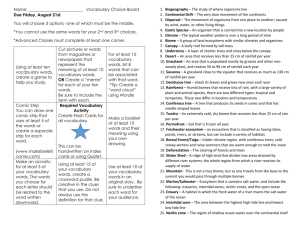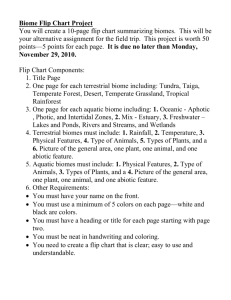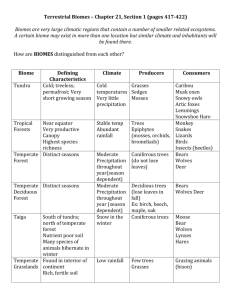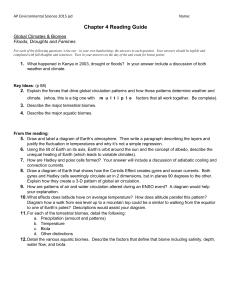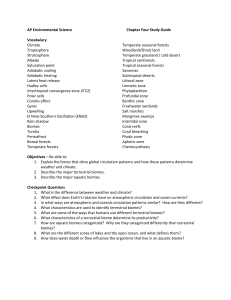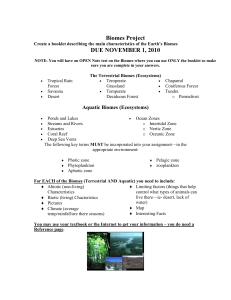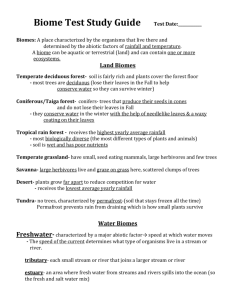Chapter 34: An Introduction to Earth*s Diverse Environments
advertisement
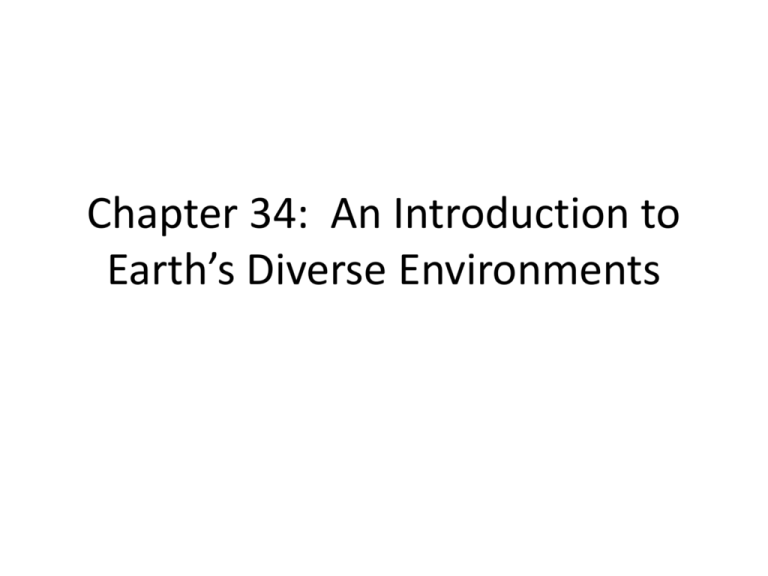
Chapter 34: An Introduction to Earth’s Diverse Environments Factors that influence environments • Abiotic: non living factors/ examples: water, air, rocks, weather • Biotic: living factors/ examples: animals, grass, trees Organization of ecosystem • Organism population community ecosystem landscapes (an array of ecosystems) Environmental problems • Overgrazing, deforestation, overcultivation of land have caused soil erosion • Manmade products get into runoff soil water supply • Pesticides and DDT sprayed on crops Physical and chemical factors that influence life in the biosphere • • • • • Energy Temperature Nutrients Aquatic factors Terrestrial factors Energy source • Plants: sunlight • Aquatic plants: sunlight at the surface • Dark environments: inorganic chemicals • Example: tube wormshas bacteria living in it that use sulfide to produce energy Temperature • Has a large effect on metabolism • Most organisms perform metabolism only at certain temps • Snowy owl: can remain considerably warmer than its surroundings so can be active at a wider range of temps Nutrients • The distribution and abundance of photosynthetic organisms depend on the availability of inorganic nutrients • Soil structure, pH and nutrient content also effect the ecosystem Other aquatic factors • Must depend on oxygen from water • Trout: require high levels of oxygen, cold and fast moving water has a higher oxygen content • Salinity • Current • tides Other terrestrial factors • Wind: increases an organism’s rate of water loss by evaporation so it results in the increase of evaporative cooling • fire Regional climate influences the distribution of terrestrial communities • Due to the Earth’s curvature there is an uneven distribution of solar energy • The sun’s rays strike the equatorial areas most directly • Any particular area of land or ocean near the equator absorbs more heat than areas in the more northern or southern lattitudes Seasons • The northern hemisphere is tilted most towards the sun in June so long days of summer in that hemisphere and in the southern hemisphere short days • Tropics: the region surrounding the equator and has the least seasonal variation in solar radiation How uneven heating causes rain and wind • High temps in the tropics evaporate water from Earth’s surface. Heated by direct rays of the sun, moist air at the equator rises creating an area of calm or very light winds known as doldrums • As warm air rises, it cools and release much of its water content creating the abundant precipitation of most tropical regions Trade winds • After losing moisture, high altitude air masses spread away from the equator until they cool • The descending dry air absorbs moisture from the land • As dry air descends some spreads back to the equator causing trade winds Prevailing winds • Result from the combined effects of the rising and falling of air masses • Slower moving surfaces produces westerlies wind that blows from the west to the east Ocean currents • Unequal heating of surface waters and the location and shapes of the continents creates ocean currents • Gulf stream circulates warm water northward from the Gulf of Mexico and makes the climate on the west coast of Great Britain warmer during winter than that coast of New England Mountains • Air temperature declines by about 6C with every 1000-m increase in elevation • Biomes: types of ecological associations that occupy broad geographic regions of land or water Aquatic biomes • Pelagic realm: all open water and seafloor (benthic realm) • Photic zone: depth of light penetration • Continental shelves: shallow areas • Aphotic zone: below photic zone 200 m to 1000m/ sometimes called the twilight zone • Intertidal zone: where the ocan meets land Plankton • Phytoplankton: photosynthesis done by algae and cyanobacteria • Zooplankton: small drifting animals Coral reefs • In the photic zone of warm tropical waters above continental shelves • Built up slowly by successive generations of coral animals and multicellular algae • Support a huge variety of invertebrates and fishes estuary • Occurs where a freshwater stream or river merges with the ocean • Among the most productive biome on Earth • Crucial nesting and feeding areas for waterfowl • Many fishes, crabs and oyster feed and breed here Wetlands • Transitional between an aquatic and terrestrial biome • Covered with water either permanently or temporarily • Supports the growth of aquatic plant growth • Mudflats and salt marshes often border wetlands Freshwater biomes • Lakes, ponds, rivers, streams and varieties of wetlands • Light, temperature, nitrogen, phosphorous all affect these biomes Terrestrial Biomes Tropical forests • Occur in equatorial areas where the temperature is warm and the days are 11-12 hours long year round • Scarce Rainfall (or a prolonged dry season) tropical dry forest prevail and find a mixture of thorny shrubs and deciduous trees and succulents Tropical rain forest • Rainfall is abundant • Up to 300 species of trees • Distinct layers: emergent trees grow above a closed upper canopy, one or tow layers of lower trees, a shrub understory and a sparse ground layer • Little sunlight reaches the ground • Many animals dwell in treesmonkeys, birds, insects, snakes, bats and frogs • Poor soil, high temps and rainfall lead to rapid decomposition Savannas • • • • • • • • • Dominated by grasses and scattered trees Warm temps year round 30-50 cm rainfall per yr. Poor soils and lack of moisture lead to little trees Grazing animals and frequent fires caused by lightning inhibit trees Grasses and forbs grow rapidly during rainy season providing a good food source for many animal species Dominant herbivores are insects especially ants and termites Common: mice, moles, gophers, snakes, ground squirrels, worms and arthropods African savannas: giraffes, zebras, antelopes, lions and cheetahs Deserts • Driest of all terrestrial biomes • Low and unpredictable rain fall • Large deserts in central Australia and northern Africa • Some are very hot and others are relatively cold Deserts continued • Cycles of growth and reproduction in the desert are keyed to rainfall • Driest: no perennial vegetation • Leaves of some plants have a waxy coating to prevent water loss Deserts • Desert animals are adapted to drought and extreme temps. • Ants, many birds, rodents, lizards, snakes, hawks Chaparral • Dense, spiny shrubs with tough evergreen leaves • Mild rainy winters and hot dry summers • Perennial shrubs • Deer, fruit eating birds and seed eating rodents like lizards and snakes Temperate grasslands • Mostly treeless except along rivers or streams • Relatively cold winter temps • 25-75 cm rainfall/year • Large grazing animals: bison and pronghorn of North America and wild horses and sheep of Asia • Birds nests on ground and some small mammals dig burrows to escape predators Temperate broadleaf forests • Sufficient moisture to support the growth of large trees • Include most of the eastern US, most of central Europe and parts of eastern Asia and Australia • Deciduous trees: oak, hickory, birch, beech maple • High annual precipitation • Invertebrates, mice, shrews, squirrels, bobcats, foxes, black bears, mountain lions Coniferous forests • Cone bearing evergreen trees like spruce, pine, fir and hemlock • AKA tiaga • Larges terrestrial biome on Earth • Long, cold winters and short, wet summers • Soil is thin and acidic • Moose, elk, hares, bears, wolves, grouse, and migratory birds Tundra • Arctic tundra encircles the North Pole • Extremely cold with little light • Permafrost: continually frozen subsoil • Musk, oxen, caribou, lemmings, arctic fox, snowy owl Water Cycle
